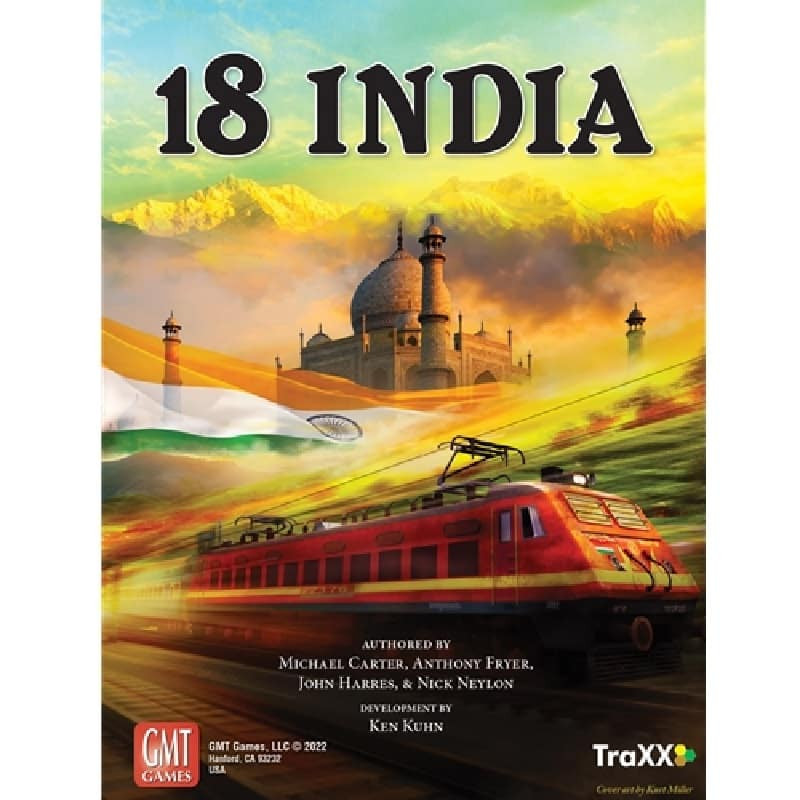- On sale!
- -50%




India's railway history commenced in 1837 with the Red Hill Railway, which employed the nation's inaugural steam-powered locomotive to transport stone for road construction to Madras, now known as Chennai. In 1845, India's first railway company, the Madras Railway, was established. Sixteen years later, on a warm April day in 1853, a 14-carriage train carrying 400 passengers was pulled for 21 miles by three steam locomotives named the Sahib, Sindh, and Sultan. This marked the inception of passenger railway services in India. From that point on, India's railway network expanded significantly, becoming the world's fourth-largest network.
Out-of-Stock
 ¿Enfundamos tus cartas?
¿Enfundamos tus cartas? Game description
Game descriptionIndia's railway history commenced in 1837 with the Red Hill Railway, which employed the nation's inaugural steam-powered locomotive to transport stone for road construction to Madras, now known as Chennai. In 1845, India's first railway company, the Madras Railway, was established. Sixteen years later, on a warm April day in 1853, a 14-carriage train carrying 400 passengers was pulled for 21 miles by three steam locomotives named the Sahib, Sindh, and Sultan. This marked the inception of passenger railway services in India. From that point on, India's railway network expanded significantly, becoming the world's fourth-largest network.
"18 India" is a railroad-themed board game designed for 2 to 5 players, with an average playtime of around 3 hours. It draws inspiration from "1829 Mainline" by Francis Tresham, incorporating innovative mechanics that differ from traditional 18XX games, particularly in eliminating in-game randomness. In "18 India," these random elements are replaced by a high degree of pre-game variability, ensuring each game session has a unique character. Notably, "18 India" challenges players to think differently about 18XX standards like train management and investments.
The game's mechanics include track gauge changes, "Guarantee Companies," competition for commodity contracts, shares with exclusive purchase rights, train trade-ins, a distinctive IPO display, and all track upgrades accessible from the game's outset. Interestingly, trains do not rust in "18 India," but there's still a sense of urgency, often referred to as the "train rush."
"18 India" offers substantial gameplay variability, with each session featuring a different mix of companies in play, resulting in variations in route development, company creation, and investment strategies.
At the end of the game, each player's net worth, considering the value of their stock portfolio, company book values, and cash, determines their final score, and the wealthiest player emerges as the winner.
While "18 India" is unquestionably an 18XX game, it introduces unique gameplay elements, setting it apart from other titles in the genre.
**GAME PLAY**
"18 India" is accessible for newcomers to 18XX games while providing rich complexity to challenge experienced players.
In most 18XX games, older trains become obsolete, or "rust," as better trains become available. However, in "18 India," trains don't rust; instead, older trains can be traded in for newer models. Companies can also buy these used trains and continue operating them, making the competition for better trains a central element of the game.
Commodity Contracts in "18 India" enable railroads to earn extra revenue by delivering goods from India's interior to its port cities. There's fierce competition to complete these commodity routes first.
The game introduces "Guarantee Companies" based on historical British Parliament practices, offering investors a 5% dividend payment even if the railroad doesn't profit.
Players draft share certificates at the start of the game, representing stock options. Besides buying certificates from the IPO and Bank Pool during Stock Rounds, players can also purchase the certificates they hold in their hand, providing capital to the corresponding company.
"18 India" features a unique Initial Public Offering (IPO) Display, affecting the timing of play through IPO share manipulation. Players can purchase shares from rows of shuffled certificates during Stock Rounds or railroad companies during Operating Rounds.
To succeed in "18 India," players must draft a coherent and flexible hand of stock options, quickly establish their first companies with sufficient capital, and balance dividend payouts with strategic withholdings. Starting additional "second wave" companies can add flexibility or complicate other players' strategies.
"18 India" is designed to play well even with just two players and has undergone extensive playtesting and refinement to create a fresh and engaging gaming experience.
**COMPONENT LIST**
- 1 22" x 34" Mounted Map
- 210 Track Tiles
- 125 Wooden Tokens
- 253 Cards
- 20 Company Charters
- 1 20-page Rulebook
 Reviews
Reviews
@CUSTOMER_NAME@
@AUTHOR_PROFILE@ @COMMENT_ISO_COUNTRY@ @VERIFY_PURCHASE@@COMMENT_TITLE@
@COMMENT_COMMENT@